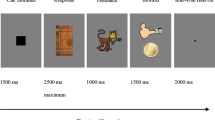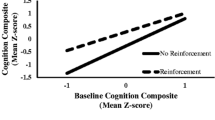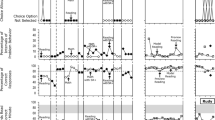Abstract
This study was designed to test the hypothesis that children with ADHD respond differently to schedules of reinforcement than children without ADHD. Nine control subjects and 11 ADHD children (all with mental retardation or borderline IQ) were tested on a cancellation task with no reinforcement and with continuous and partial reinforcement. Magnitude of reinforcement was held constant by giving equal numbers of reinforcers during continuous and partial reinforcement. Both schedules of reinforcement produced significant improvements over baseline, which demonstrates once again the positive effect of reinforcement in shaping and maintaining adaptive behavior. However, there were no appreciable differences between groups in their responses to reinforcement schedules. This challenges the validity of a common explanation of the cause of ADHD.
Similar content being viewed by others
REFERENCES
Alabiso, F. (1975). Operant control of attention behavior: a treatment for hyperactivity. Behav. Ther. 6: 39–42.
Allyon, T., Layman, D., and Kandel, H. J. (1975). A behavioral-educational alternative to drug control of hyperactive children. J. Appl. Behav. Anal. 8(2): 137–146.
Aman, M. G. (1996). Annotated bibliography on the Aberrant Behavior Checklist (ABC), Unpublished manuscript, Ohio State University, Columbus, Ohio.
Aman, M. G., and Singh, N. N. (1986). Manual for the Aberrant Behavior Checklist, Slosson Educational Publications, East Aurora, New York.
Aman, M. G., and Singh, N. N. (1994). Supplement to the Aberrant Behavior Checklist. East Aurora, Slosson Educational Publications, New York.
Aman, M. G., Tassé, M. J., Rojahn, J., and Hammer, D. (1996). The Nisonger CBRF: a child behavior rating form for children with developmental disabilities. Res. Develop. Dis. 17: 41–57.
Aman, M. G., and Turbott, S. H. (1986). Incidental learning, distraction, and sustained attention in hyperactive and control subjects. J. Abnorm. Child Psychol. 14: 441–455.
American Psychiatric Association (1994). Diagnostic and Statistical Manual of Mental Disorders (fourth edition), Washington, DC: Author.
Axelrod, S. (1971). Token reinforcement programs in special classes. Excep. Child. 37: 371–379.
Barkley, R. A. (1987). The assessment of Attention-Deficit Hyperactivity Disorder. Behav. Assess. 9: 207–233.
Barkley, R. A. (1990a). The problem of stimulus control and rule-governed behavior in Attention Deficit Disorder with Hyperactivity. In Swanson, J., and Bloomingdale, L. (eds.), Attention Deficit Disorders (Vol. 4), Pergamon Press, New York.
Barkley, R. A. (1990b). Attention Deficit Hyperactivity Disorder: A Handbook for Diagnosis and Treatment, Guilford Press, New York.
Christensen, D. E. (1975). Effects of combining methylphenidate and a classroom token system in modifying hyperactive behavior. Am. J. Ment. Def. 80: 266–276.
Conners, C. K. (1969). A teacher rating scale for use in drug studies with children. Am. J. Psychiatry 126: 884–888.
Conners, C. K. (1973). Rating scales for use in drug studies with children. Psychopharmacol. Bull. [Special issue: Pharmacotherapy with children], 9: 24–84.
Conners, C. K. (1990). Conners Rating Scales Manual, Multi-Health Systems, Inc., Toronto, Ontario.
Cunningham, S. J., and Knights, R. M. (1978). The performance of hyperactive and normal boys under differing reward and punishment schedules. J. Pediatr. Psychol. 3: 195–201.
Douglas, V. I. (1985). The response of ADD children to reinforcement: Theoretical and clinical implications. In Bloomingdale, L. M. (ed.), Attention Deficit Disorder: Identification, Course, and Treatment Rationale, Spectrum Publications, Inc., New York, pp. 49–66.
Douglas, V. I. (1990). Can Skinnerian theory explain Attention Deficit Disorder? A reply to Barkley. In Swanson, J., and Bloomingdale, L. (eds.), Attention Deficit Disorders (Vol. 4), Pergamon Press, New York.
Douglas, V. I., and Parry, P. A. (1983). Effects of reward on delayed reaction time task performance of hyperactive children. J. Abnorm. Child Psychol. 11: 313–326.
Freibergs, V., and Douglas, V. I. (1969). Concept learning in hyperactive and normal children. J. Abnorm. Psychol. 74: 388–395.
Goyette, C. H., Conners, C. K., and Ulrich, R. F. (1978). Normative data on Revised Conners Parent and Teacher Rating Scales. J. Abnorm. Child Psychol. 6: 221–236.
Houlihan, M., and VanHouten, R. (1989). Behavioral treatment of hyperactivity: A review and overview. Educ. Treat. Child. 12(3): 265–275.
Huitema, B. E. (1980). The Analysis of Covariance and Alternatives, Wiley, New York.
Keogh, B. K., and Margolis, J. S. (1976). A component analysis of attentional problems of educationally handicapped boys. J. Abnorm. Child Psychol. 4: 349–359.
MacKintosh, N. J. (1974). The Psychology of Animal Learning, Academic Press, London.
Mash, E. J., and Dalby, J. T. (1979). Behavioral interventions for hyperactivity. In Trites, R. L. (ed.), Hyperactivity in Children: Etiology, Measurement, and Treatment Implications, University Park Press, Baltimore, pp. 161–216.
O'Leary, S. G., and Pelham, W. E. (1977). Behavior therapy and withdrawal of stimulant medication with hyperactive children. Pediatrics 61: 211–217.
Parry, P. A. (1973). The effect of reward on the performance of hyperactive children. Unpublished doctoral dissertation, McGill University.
Parry, P. A., and Douglas, V. I. (1983). Effects of reinforcement on concept identification in hyperactive children. J. Abnorm. Child Psychol. 11: 327–340.
Patterson, G. R., Jones, R., Whittier, J. E., and Wright, M. A. (1965). A behaviour modification technique for the hyperactive child. Behav. Res. Ther. 2: 217–226.
Pelham, W. E., Milich, R., and Walker, J. L. (1986). Effects of continuous and partial reinforcement and methylphenidate on learning in children with Attention Deficit Disorder. J. Abnorm. Psychol. 95: 319–325.
Quay, H. C., Sprague, R. L., Werry, J. S., and McQueen, M. M. (1967). Conditioning visual orientation of conduct problem children in the classroom. J. Exp. Child Psychol. 5: 512–517.
SAS Institute. (1990). Elementary Statistical Analysis System, SAS Institute, Inc., Cary, NC.
Sattler, J. M. (1992). The Assessment of Children (Revised and updated third edition), JM Sattler Publishers, Inc., San Diego.
Siegel, S. (1956). Nonparametric Satisties for the Bhavioral Siences, McGraw-Hill Book Company Inc., New York.
Twardosz, S., and Sajwaj, T. (1972). Multiple effects of a procedure to increase sitting in a hyperactive, retarded boy. J. Appl. Behav. Anal. 5: 73–78.
Wender, P. H. (1971). Minimal Brain Dysfunction in Children, Wiley-Interscience, New York.
Wolraich, M., Drummond, T., Salomo.n, M. K., O'Brien, M. L., and Sivage, C. (1978). Effects of methylphenidate alone and in combination with behavior modification procedures on the behavior and academic performance of hyperactive children. J. Abnorm. Child Psychol. 6:149–161.
Wulbert, M., and Dries, R. (1977). The relative efficacy of methylphenidate (Ritalin) and behavior modification techniques in the treatment of a hyperactive child. J. Appl. Behav. Anal. 10: 21–31.
Author information
Authors and Affiliations
Rights and permissions
About this article
Cite this article
DeWitt, M.B., Aman, M.G. & Rojahn, J. Effects of Reinforcement Contingencies on Performance of Children with Mental Retardation and Attention Problems. Journal of Developmental and Physical Disabilities 9, 101–115 (1997). https://doi.org/10.1023/A:1024973618256
Issue Date:
DOI: https://doi.org/10.1023/A:1024973618256




